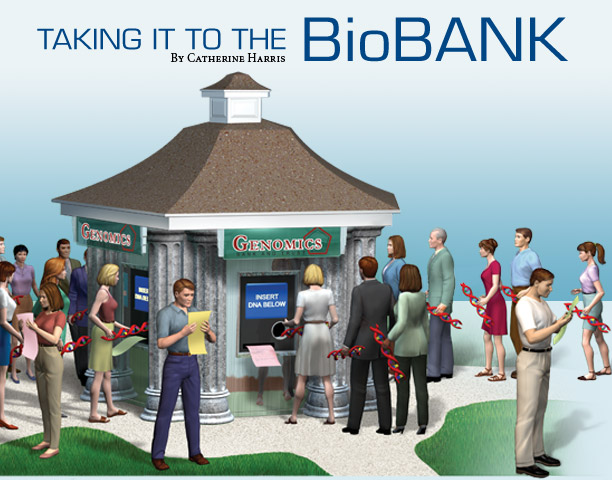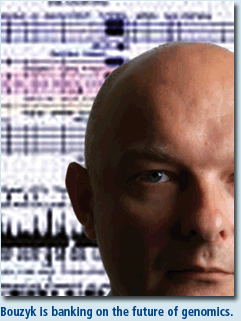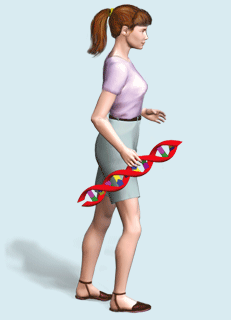|












|
 |
| |
|
|
| |
 E-mail to a Friend
E-mail to a Friend
 Printer Friendly
Printer Friendly |
|
| |
|
|
| |
Ask
Mark Bouzyk to tell you what he does, and his answer depends on
who is asking the question. |
|
| |
|
|
| |
If
you’re a clinical investigator looking to add genetic analysis
to your federally funded study, he might talk to you about the need
to select the most appropriate (and cost-efficient) genotyping platform.
He might tell public health faculty about his plans to partner with
the American Cancer Society (ACS) to design a large-scale population
study in search of genetic links to breast cancer and obesity. He
might share information with researchers at the Winship Cancer Institute
to help them determine why some patients do well on a trial drug
while others do not.
In short, Mark Bouzyk—who became
director of the Center for Medical Genomics (CMG) just over a year
ago—is banking on the future of genomics. He sees enormous
untapped potential for clinical genetics at Emory, and he wants
to invest for the future.
“The costs of sequencing and
genotyping have dropped considerably in the past three years. Now
high-throughput genetic analysis is within the budget of many typical
NIH RO1 research grants,” he says. “Just a short time
ago, it was prohibitively expensive.”
This drop in cost, coupled with a
wealth of information about the human genome now in the public domain,
has enabled Emory both to pursue cutting-edge genetic research and
to develop new genetic and diagnostic screening tools.
For example, a key focus of the CMG
is on single nucleotide polymorphisms (SNPs). These are DNA sequence
variations that occur when a single nucleotide in the genome differs
among members of the same species. SNPs with a minor allele frequency
of greater than 1% occur approximately every 300 bases along the
human genome, and these common SNPs make up 90% of human genetic
variations. These variations in the DNA can affect how different
humans respond to diseases, bacteria, viruses, and drugs.
More 10 million SNPS have been identified
and mapped on the human genome—in specific study populations
can yield important information about genetic predisposition to
disease and how effective different treatments will be. |
|
| |
|
|
| |
Creating
genetic wealth |
|
| |
Under
the leadership of geneticist Steven Warren, Emory established the
CMG in 2002 to provide DNA extraction, storage, and analysis capabilities
in support of work done by faculty in the Department of Human Genetics.
In August 2005, the center moved into a brand new high-throughput
genetic analysis lab in the same building with geneticists who counsel
patients about risk factors for disease. The CMG is gearing up to
rapidly translate new genetic knowledge into new diagnostic tools.
Currently, the center is seeking certification
as a clinical lab through the College of American Pathologists and
meeting requirements of the federal Clinical Laboratory Improvements
Act. With blessing from these organizations, it can pursue development
of clinical tests that follow through on its basic science discoveries.
With blessing from these organizations, it can pursue development
of clinical tests that follow through on its basic science discoveries.
“If we find that a gene is linked
to a particular disease or condition, then we can develop a diagnostic
test and pass it down the corridor,” says Bouzyk.
In addition, the center provides support
to investigators across the health sciences who want to incorporate
genetic studies into other research. With gene sequencing and genotyping
technologies becoming less expensive, many investigators can now
afford to perform either whole or partial genome scanning or large-scale
candidate gene analysis in search of variations linked to a specific
disease or trait of interest. However, first they need to know which
techniques are best suited to the questions they are trying to ask.
That’s where the CMG comes in.
The center also can help investigators
determine the affordability of the technology. For example, where
some studies may project an average cost of $1 per genotype, the
center may be able to reduce this cost by 30 cents or even much
lower, through a combination of elegant study design and targeted
selection of the right technology. |
|
| |
|
|
| |
Transferring
savings |
|
| |
Prior
to joining Emory, Bouzyk worked for pharmaceutical giant GlaxoSmithKline,
studying the ways that genetic variations indicate which people
are better candidates for a particular drug. If drug companies can
identify who has the most potential to do well on a drug, they are
able to more closely select clinical trial participants for drugs
that might perform less well in trials using a broader selection
of the general public.
“That’s the big thing
the pharmaceutical companies are doing now,” Bouzyk says.
“If they have a drug that did well in some patients but showed
no response in others, they look at the genotypes of the people
who did well to identify a common polymorphism that can indicate
whether a particular subset of people will respond differently.”
But Bouzyk left the lucrative corporate
sector after eight years because he saw a way to do genetic research
on a large scale—to add genetic analysis to almost any medical
or clinical research project going. “Now that these technologies
are more affordable, there is real potential to use them to benefit
whole populations of people, to really expand our knowledge of genetics
and the causes of disease,” he says. “I felt that an
academic medical center would be the best place to pursue this type
of research. And Emory, because of its proximity to the CDC, the
ACS, and the Carter Center, is ideal.”
Bouzyk also is interested in
research examining why African Americans experience higher rates
of many disorders, including stroke and heart disease compared with
the rest of the population. With a large African American population
in its backyard, Emory is particularly well suited to examine possible
genetic factors that might play a role in such disparities. |
|
| |
|
|
| |
Collecting
deposits |
|
| |
As
much as scientists know about the links between genes and specific
diseases, it’s barely a drop in the bucket of the knowledge
that’s out there, says Bouzyk.
Eventually, researchers hope to under-stand
enough of the complex interactions between genes and the environment
to reliably predict and prevent disease before it occurs. To do
that, however, they will have to drastically increase the genetic
information currently available.
To determine if any single polymorphism
or mutation is associated with a disorder may require the genotyping
of thousands of different individuals. To determine how genes and
other factors interact involves the study of genetic samples taken
from large numbers of people.
Already, medical centers across the
country are scrambling to find ways to harvest the genetic data
from the thousands of biologic samples they obtain for clinical
studies on a regular basis. The successful ones have formed “biobanks”
that store large numbers of these samples linked to demographic
information about the donor, says Bouzyk. These centers enjoy a
distinct advantage when it comes to seeking federal support and other research funding.
comes to seeking federal support and other research funding.
As the site of one of 60 federally
funded General Clinical Research Centers, Emory is ideally positioned
to start its own biobank—collecting and maintaining large
stores of biologic samples for future genetic studies. Each year,
the center conducts clinical trials involving people from all walks
of life. Preserving biologic samples from these trials will one
day yield a wealth of genetic information.
“Across Emory, we have a large
number of world-class studies—for example, in neurology and
cardiology—that collect biologic samples we could store,”
Bouzyk says. “If we can build on these collections across
all disease and therapeutic areas and organize and make them available,
this asset would be considerable.”
Yet Bouzyk acknowledges this will
take a large effort in logistics as well as grappling with issues
such as IT, sample information and distribution status, and consent.
Currently, the CMG is working to establish a process for obtaining
consent from donors for future use of this genetic information.
As with other biobanks, information
about the samples stored at Emory could be shared via the Internet,
enabling researchers from around the world to find samples that
would potentially aid their research. The biobank also would link
Emory’s researchers to far-flung collaborators who could help
further their own studies.
“The concept of a biobank has
enormous support across the different schools and centers at Emory,”
says Bouzyk. “We’ve been talking about this for some
time, and now we are finally at the point we can do something about
it.”
Catherine
Harris is the former editor of this magazine. |
|
| |
|
|
| |
|
|
|
|
|

